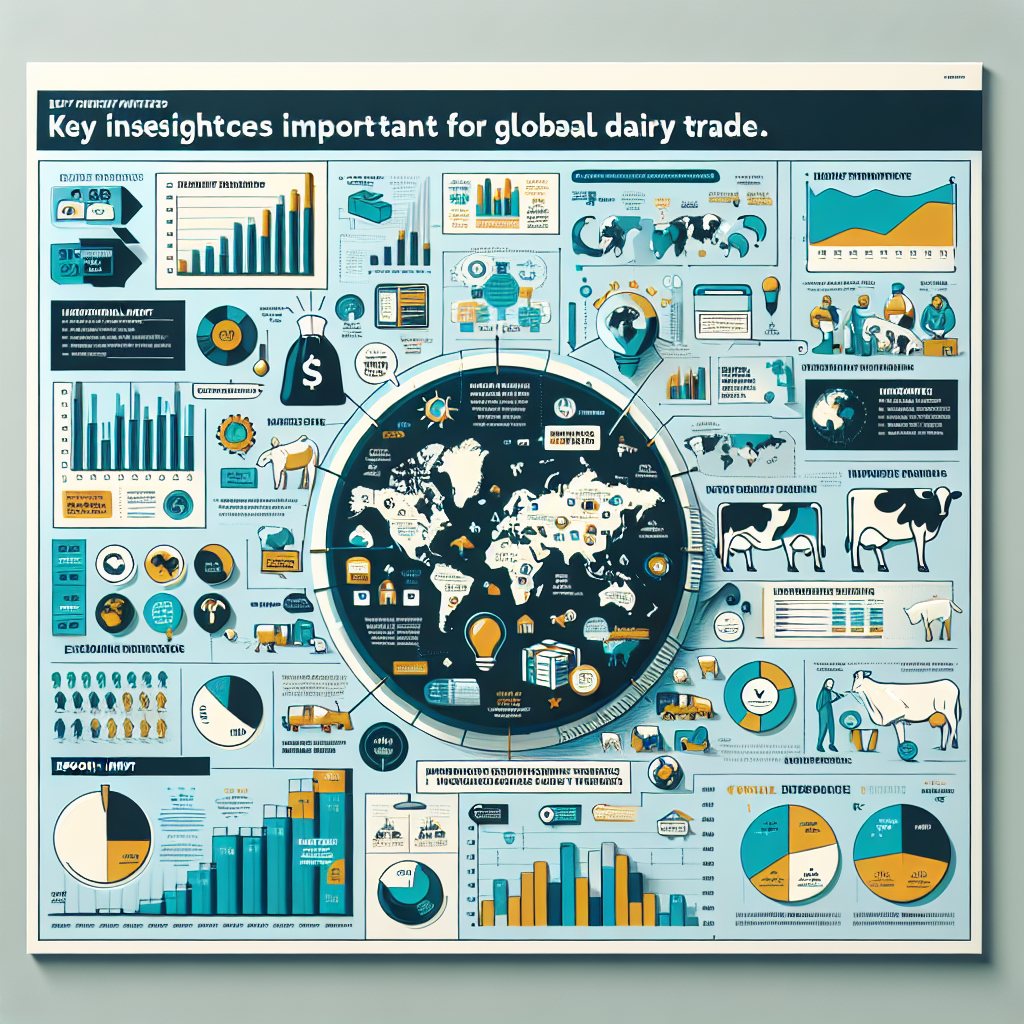Learn why global dairy trade reports are crucial for US dairy farmers and how international trends impact your business competitiveness.
Summary: Global Dairy Trade (GDT) reports play a pivotal role in providing U.S. dairy farmers with critical insights into international market dynamics, aiding in strategic decision-making, pricing optimization, risk management, and benchmarking against global competitors. By understanding and navigating the complex landscape of international trade policies, regulations, and emerging trends, including climate change, technology, and evolving consumer preferences, U.S. dairy farmers can better position themselves in the global market. These reports offer a strategic advantage in staying competitive and making informed choices that align with the rapidly changing global dairy industry. Moreover, GDT reports impact decisions like feed pricing and cheese demand by providing a comprehensive understanding of market trends, enabling US dairy producers to anticipate potential surpluses or shortages, plan production, and set competitive rates for dairy products.
- GDT reports provide critical insights into international market dynamics for U.S. dairy farmers.
- They aid in strategic decision-making, pricing optimization, risk management, and benchmarking.
- Understanding global trade policies and regulations helps in navigating the complex market landscape.
- Emerging trends such as climate change, technology, and consumer preferences are crucial.
- GDT reports offer a strategic advantage to stay competitive in the global dairy industry.
- These reports help in making informed decisions regarding feed pricing and cheese demand.
- They enable U.S. dairy producers to anticipate market trends and plan production accordingly.

Did you realize that changes in global dairy markets might affect your bottom line as a US dairy farmer? Discuss why Global Dairy Trade (GDT) reports are essential. You could question, “Why should I care about markets halfway around the world?” The solution is straightforward: interconnectivity. Global dynamics impact your choice, ranging from feed pricing to cheese demand. Understanding these reports is a need, not a luxury. Ignoring the GDT reports is like driving with closed eyes; you’ll soon strike a wall. Join us as we walk you through GDT reports, providing insights into their influence on you. Discover how global trends impact your local economy, including milk pricing and export potential.
The Crucial Role of Global Dairy Trade Reports in Understanding Market Dynamics
Global dairy trade reports are crucial for comprehending the dairy market’s complex dynamics. These papers contain thorough information about the worldwide dairy industry’s trade activity, pricing patterns, and supply-demand situations. Significantly, they come from a variety of reliable sources.
One of the primary sources is the Global Dairy Trade (GDT) platform. GDT holds frequent trade events to auction dairy items such as milk powder, butter, and cheese. The outcomes of these events are thoroughly recorded and often referenced by industry players.
USDA reports are another vital resource. The United States Department of Agriculture publishes extensive studies on many areas of the dairy industry, such as production, export statistics, and domestic consumption trends. These reports are highly respected due to their depth and correctness.
International market assessments done by different research institutes and consultancies significantly add to the dairy trade report corpus. These evaluations often include macroeconomic views, trade policy implications, and future market projections, allowing stakeholders to make educated choices.
These sources provide a comprehensive understanding of the worldwide dairy market, which is critical for farmers, dealers, and policymakers.
Harnessing Global Dairy Trade Reports for Strategic Decision-Making in U.S. Dairy Farming
Monitoring global dairy trade data is critical for acquiring a complete understanding of market trends, which have a direct influence on US dairy producers’ strategic choices. These papers thoroughly examine supply and demand dynamics, emphasizing changes that may affect local and worldwide market circumstances. Understanding these trends enables you to anticipate possible surpluses or shortages, allowing you to plan your production and marketing plans better.
Price changes are another critical issue highlighted by these publications. You’ll discover information on how global events, seasonal fluctuations, and changes in consumer behavior influence dairy prices. For example, information from events such as the TE-369 and TE-373 give a history of price patterns across consecutive periods, allowing you to identify critical movements and, more precisely, anticipate future prices.
Furthermore, these studies give insight into new markets, pinpointing areas where demand for dairy products is increasing. Staying up-to-date on industry trends allows you to identify new possibilities and customize goods to changing customer tastes. Events like TE-365 and TE-377 showcase these developing trends, providing vital information that may help you diversify and broaden your market presence.
Importance of Market Trends: Discuss how global dairy trade reports give information on supply and demand dynamics, price volatility, and growing markets.
Strategically Pricing Your Dairy Products
Understanding global dairy prices may significantly influence pricing tactics. Monitoring these worldwide reports gives insight into patterns and changes in foreign marketplaces. Analyzing data from events such as the Global Dairy Trade Trading Event TE-373 and TE-378 allows you to determine the supply and demand balance influencing pricing.
This information allows you to establish competitive rates for dairy products that are neither too expensive to dissuade prospective customers nor too cheap to jeopardize profitability. In essence, this strategic strategy helps you maximize your profits.
Furthermore, it enables you to change your manufacturing and marketing strategy in response to real-time market circumstances. For example, if worldwide prices rise, you may delay selling your goods to profit from higher future pricing. If an overstock is expected, you might act swiftly to sell at present levels before prices fall.
Finally, remaining informed with global dairy trade reports allows you to make data-driven choices, which boosts both short-term income and long-term performance in the competitive dairy industry.
Mastering Risk Management with Global Dairy Trade Reports
Robust risk management solutions are required while navigating the dairy industry’s turbulent seas. Global Dairy Trade (GDT) reports might be helpful in this situation. Analyzing these data thoroughly might provide insights into industry patterns and anticipated price variations. This lets you predict future market volatility and proactively change your production levels and investment plans, protecting your bottom line.
For example, examining historical data and GDT events’ current patterns might warn you of potential supply and demand adjustments. If recent GDT results indicate that global cheese prices may climb, you may consider increasing your cheese production to take advantage of rising pricing. If a slump is expected, you may reduce spending to avoid losses. This foresight is critical in allowing you to make educated choices that will stabilize your operations and secure long-term profitability.
Moreover, GDT reports may help you diversify your investing portfolio. Understanding market trends allows you to invest smartly in equipment, technology, or even new dairy products that will likely provide better profits. In essence, these reports are more than data points; they are strategic tools that can help you handle market unpredictability confidently and accurately.
Benchmarking with Global Industry Leaders
By reviewing Global Dairy Trade (GDT) statistics, you may compare critical indicators such as production costs, profit margins, and market trends to those of foreign rivals. This benchmarking shows you where you stand on a worldwide scale. Are the manufacturing expenses much more significant than those in Europe or New Zealand? The research shows such differences, shedding light on possible areas for cost-cutting and operational improvements.
Furthermore, GDT publications highlight new trends and creative techniques global industry leaders use. For example, if statistics indicate increased demand for organic dairy products in Australia, you may consider extending your organic goods to reach new market groups. Identifying these patterns early will help you stay ahead of the curve, keeping your farm competitive in a constantly changing market.
By incorporating best practices and creative techniques from top-performing nations, you may improve your operations and position yourself as a forward-thinking leader in the US dairy business. So, use these reports to identify shortcomings, capitalize on strengths, and promote continual development and innovation.
Navigating the Complex Landscape of International Trade Policies and Regulations
Understanding international trade rules and regulations is essential for successful dairy farming businesses. Global Dairy Trade Reports provide information on tariffs, trade obstacles, and global policy changes. For example, these reports often emphasize any changes in import duties by major dairy-consuming nations that may impair the competitiveness of US exports. They can give insights into new trade agreements or changes in current restrictions, allowing you to adjust your approach accordingly.
With these detailed studies, you’ll better manage the complex web of global dairy trade regulations. For example, understanding policy changes in the European Union or China might help you forecast market swings and appropriately alter your production plans. By remaining updated via these reports, you may reduce the risks connected with regulatory changes while capitalizing on possibilities created by new trade agreements, ensuring that your operations remain robust and competitive in the global market.
Navigating Future Global Dairy Trade Trends: Embracing Climate Change, Technology, and Consumer Preferences
Climate change, technological developments, and changing consumer tastes are all expected to influence global dairy trade patterns. For example, rising demand for plant-based alternatives may impact the dairy market, encouraging conventional dairy producers to diversify. Furthermore, technological developments like precision farming and blockchain for supply chain transparency may become more common, allowing farmers to improve efficiency and product traceability.
U.S. dairy producers should consider adopting sustainability techniques to appeal to environmentally sensitive customers and keep ahead of the competition. Keeping up with technology changes and using solutions to increase operational efficiency will also be critical. Participating in cooperative enterprises may bring helpful market insights and a more powerful negotiating stance. Furthermore, continuously following Global Dairy Trade data will give farmers a competitive advantage, allowing them to anticipate market changes and make educated choices.
By being proactive and adaptive, US dairy farmers can manage the challenges of the growing global dairy market and guarantee their position in the future.
The Bottom Line
The importance of Global Dairy Trade (GDT) studies in giving practical data to US dairy producers cannot be emphasized. Integrating the richness of information included in GDT reports into your business strategy enables you to make better-educated choices that will position your farm for success. Consider this: How can you use the most recent market trends to better your operations and remain ahead of the curve? Embracing these ideas may be the key to surviving and prospering in an increasingly complicated global economy. So, take action, read these reports, and let the facts lead you to success.














